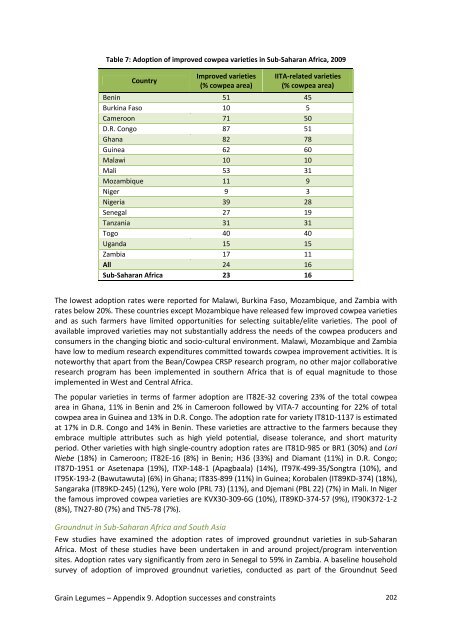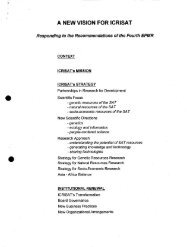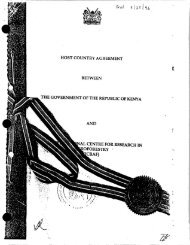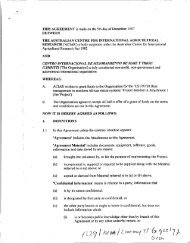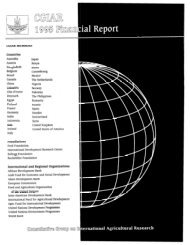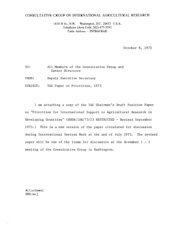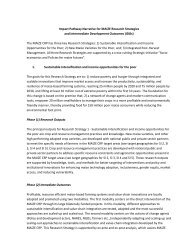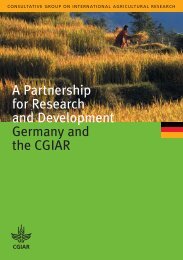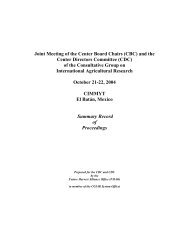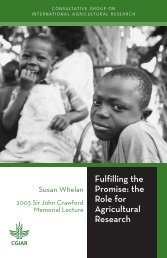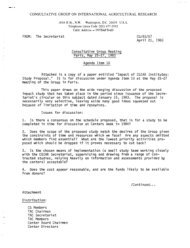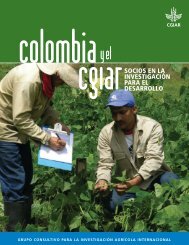CGIAR Research Program on Grain Legumes: Proposal - Library
CGIAR Research Program on Grain Legumes: Proposal - Library
CGIAR Research Program on Grain Legumes: Proposal - Library
- No tags were found...
Create successful ePaper yourself
Turn your PDF publications into a flip-book with our unique Google optimized e-Paper software.
Table 7: Adopti<strong>on</strong> of improved cowpea varieties in Sub-Saharan Africa, 2009CountryImproved varieties(% cowpea area)IITA-related varieties(% cowpea area)Benin 51 45Burkina Faso 10 5Camero<strong>on</strong> 71 50D.R. C<strong>on</strong>go 87 51Ghana 82 78Guinea 62 60Malawi 10 10Mali 53 31Mozambique 11 9Niger 9 3Nigeria 39 28Senegal 27 19Tanzania 31 31Togo 40 40Uganda 15 15Zambia 17 11All 24 16Sub-Saharan Africa 23 16The lowest adopti<strong>on</strong> rates were reported for Malawi, Burkina Faso, Mozambique, and Zambia withrates below 20%. These countries except Mozambique have released few improved cowpea varietiesand as such farmers have limited opportunities for selecting suitable/elite varieties. The pool ofavailable improved varieties may not substantially address the needs of the cowpea producers andc<strong>on</strong>sumers in the changing biotic and socio-cultural envir<strong>on</strong>ment. Malawi, Mozambique and Zambiahave low to medium research expenditures committed towards cowpea improvement activities. It isnoteworthy that apart from the Bean/Cowpea CRSP research program, no other major collaborativeresearch program has been implemented in southern Africa that is of equal magnitude to thoseimplemented in West and Central Africa.The popular varieties in terms of farmer adopti<strong>on</strong> are IT82E-32 covering 23% of the total cowpeaarea in Ghana, 11% in Benin and 2% in Camero<strong>on</strong> followed by VITA-7 accounting for 22% of totalcowpea area in Guinea and 13% in D.R. C<strong>on</strong>go. The adopti<strong>on</strong> rate for variety IT81D-1137 is estimatedat 17% in D.R. C<strong>on</strong>go and 14% in Benin. These varieties are attractive to the farmers because theyembrace multiple attributes such as high yield potential, disease tolerance, and short maturityperiod. Other varieties with high single-country adopti<strong>on</strong> rates are IT81D-985 or BR1 (30%) and LoriNiebe (18%) in Camero<strong>on</strong>; IT82E-16 (8%) in Benin; H36 (33%) and Diamant (11%) in D.R. C<strong>on</strong>go;IT87D-1951 or Asetenapa (19%), ITXP-148-1 (Apagbaala) (14%), IT97K-499-35/S<strong>on</strong>gtra (10%), andIT95K-193-2 (Bawutawuta) (6%) in Ghana; IT83S-899 (11%) in Guinea; Korobalen (IT89KD-374) (18%),Sangaraka (IT89KD-245) (12%), Yere wolo (PRL 73) (11%), and Djemani (PBL 22) (7%) in Mali. In Nigerthe famous improved cowpea varieties are KVX30-309-6G (10%), IT89KD-374-57 (9%), IT90K372-1-2(8%), TN27-80 (7%) and TN5-78 (7%).Groundnut in Sub-Saharan Africa and South AsiaFew studies have examined the adopti<strong>on</strong> rates of improved groundnut varieties in sub-SaharanAfrica. Most of these studies have been undertaken in and around project/program interventi<strong>on</strong>sites. Adopti<strong>on</strong> rates vary significantly from zero in Senegal to 59% in Zambia. A baseline householdsurvey of adopti<strong>on</strong> of improved groundnut varieties, c<strong>on</strong>ducted as part of the Groundnut Seed<strong>Grain</strong> <strong>Legumes</strong> – Appendix 9. Adopti<strong>on</strong> successes and c<strong>on</strong>straints 202


